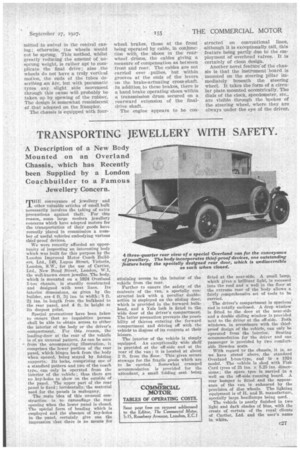TRANSPORTING JEWELLERY WITH SAFETY.
Page 49

If you've noticed an error in this article please click here to report it so we can fix it.
A Description of a New Body Mounted on an Overland Chassis, which has Recently been Supplied by a London Coachbuilder to a Famous Jewellery Concern.
THE conveyance of jewellery and other valuable articles of small bulk necessarily involves the taking of extra precautions against theft. For this reason, some large modern jewellery concerns which have adopted motors for the transportation of their goods have recently placed in commission a number of useful vehicles embodying various thief-proof devices.
We were recently afforded an opportunity of inspecting an interesting body which was built for this purpose by the London Improved Motor Coach Builders, Ltd., 149, Lupus Street, Victoria, London, S.W., for the use of Cartier, Ltd., New Bond Street, London, 'W.1, the well-known court jeweller. The body, which is mounted on a 1924 Overland 1-ton chassis, is sturdily constructed and designed with neat lines. Its interior dimensions, as given by the builder, are 4 ft. 34 ins, in width; ft. 2i ins, in length from the bulkhead to the rear panel, and 4 ft. in height at its deepest point.
Special precautions have been taken to ensure that no inquisitive person shall be able to obtain access to either the interior of the body or the driver's compartment. For this reason, the loading-door at the rear of the vehicle is of an unusual pattern. As can be seen from the accompanying illustration, it comprises the lower portion of the rear panel, which hinges back from the body when opened, being stayed by folding supports_ Its locks, comprising one of a standard pattern and two of the coach type, can only be operated from the interior of the vehicle ; thus there are eo key-holes to show on the outside of the panel. The upper part of the rear panel is fixed ; incidentally, the material used for the panels is mahogany.
The main idea of this unusual construction isto camouflage the rear opening when the lower panel is closed. The special form of beading which is employed and the absence of key-holes in the panel, certainly give one the impression that there is no means fur attaining access to the interior of the vehicle from the rear.
Further to ensure the safety of the contents of the van, a specially constructed lock with a Peculiar doubleaction is employed on the Sliding door, which is provided in the forward bulkhead, and a Yale lock is fitted to the wide door of the driver's &impartment. The latter precaution prevents the possibility of thieves entering the forward compartment and driving off with the vehicle to dispose of its contents at their leisure.
The interior of the vehicle is simply equipped. An exceptionally wide shelf is provided at the off-side and at the rear of the van; it is located at about 2 ft. from the floor. This gives secure stowage for the fragile goods which are to be carried. Somewhat cramped accommodation is provided for the attendant, a small folding seat being
fitted at the near-side. A small lamp, which gives a brilliant light, is recessed into the roof and a well in the floor at the extreme rear of the body allows a fairly comprehensive set of tools to be carried.
The driver's compartment is spacious' and is totally enclosed. A drop window is fitted to the door at the near-side and a double sliding window is provided next to the driver at the off-side. Both windows, in accordance with the thiefproof design of the vehicle, can only be operated from the interior. Seating accommodation for the driver and one passenger is provided by two comfortable Bowden seats.
With regard to the chassis, it is, as we have stated above, -the standard Overland 1-ton-type, aid is a 1924 model. The vehicle is shod with Fisk Cord tyres of 31 ins. x 5.25 ins, dimensions; the spare tyre is carried in a well on the off-side running board. A rear bumper is fitted and the appearance of the van is enhanced by the provision of disc. wheels. The lighting equipment is of IL and B. manufacture, specially large headlamps being used. The vehicle is neatly finished in two light and dark shades of blue, with the crests of certain of the royal clients of Cartier, Ltd. and the user's name in white.












































































































